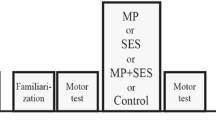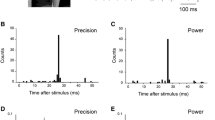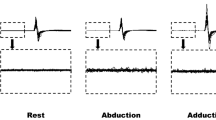Abstract
Animal models reveal that correlated afferent inputs are a powerful driver of sensorimotor cortex reorganisation. Recently we developed a stimulation paradigm, which evokes convergent afferent input from two hand muscles and induces reorganisation within human motor cortex. Here we investigated whether this reorganisation is characterised by expansion and greater overlap of muscle representation zones, as reported in animal models. Using transcranial magnetic stimulation, we mapped the motor representation of the right first dorsal interosseous (FDI), abductor digiti minimi (ADM) and abductor pollicis brevis (APB) in 24 healthy subjects before and after 1 h of (1) associative stimulation to FDI and ADM motor points, (2) associative stimulation to digits II and V (3) a control condition employing non-correlated stimulation of FDI and ADM motor points. Motor point associative stimulation induced a significant increase in the number of active sites in all three muscles and volume in FDI and ADM. Additionally, the centre of gravity of the FDI and ADM maps shifted closer together. Similar changes were not observed following digital associative stimulation or motor point non-associative stimulation. These novel findings provide evidence that convergent input induces reorganisation of the human motor cortex characterised by expansion and greater overlap of representational zones.



Similar content being viewed by others
References
Byl NN, Merzenich MM, Jenkins WM (1996) A primate genesis model of focal dystonia and repetitive strain injury: I. Learning-induced dedifferentiation of the representation of the hand in the primary somatosensory cortex in adult monkeys. Neurology 47:508–520
Byrnes ML, Thickbroom GW, Wilson SA, Sacco P, Shipman JM, Stell R, Mastaglia FL (1998) The corticomotor representation of upper limb muscles in writer’s cramp and changes following botulinum toxin injection. Brain 121:977–988
Clark SA, Allard T, Jenkins WM, Merzenich MM (1988) Receptive fields in the body-surface map in adult cortex defined by temporally correlated inputs. Nature 332:444–445
Cheney PD, Fetz EE (1980) Functional classes of primate corticomotoneruonal cells and their relation to active force. J Neurophysiol 44:773–791
Cohen LG, Bandinelli S, Findley TW, Hallett M (1991) Motor reorganization after upper limb amputation in man. A study with focal magnetic stimulation. Brain 114(Pt 1B):615–627
Day BL, Dressler D, Maertens de Noordhout A, Marsden CD, Nakashima K, Rothwell JC, Thompson PD (1989) Electric and magnetic stimulation of human motor cortex: surface EMG and single motor unit responses. J Physiol 412:449–473
Godde B, Spengler F, Dinse HR (1996) Associative pairing of tactile stimulation induces somatosensory cortical reorganization in rats and humans. Neuroreport 8:281–285
Hamdy S, Rothwell JC, Aziz Q, Singh KD, Thompson DG (1998) Long-term reorganization of human motor cortex driven by short-term sensory stimulation. Nat Neurosci 1:64–68
Hebb D (1949) The organization of behavior. Wiley, New York
Lemon RN, Bennett KB, Werner W (1991) The cortico-motor substrate for skilled movements of the primates hand. In: Stelmach GE, Requin J (eds) Tutorials on motorneuroscience. vol 62: Kluwer, Holland, pp 477–495
Liepert J, Terborg C, Weiller C (1999) Motor plasticity induced by synchronized thumb and foot movements. Exp Brain Res 125:435–439
Miles TS, Ridding MC, McKay D, Thompson PD (2005) Motor cortex excitability after thalamic infarction. J Clin Neurosci 12:469–472
Miranda PC, de Carvalho M, Conceicao I, Luis ML, Ducla-Soares E (1997) A new method for reproducible coil positioning in transcranial magnetic stimulation mapping. Electroencephalogr Clin Neurophysiol 105:116–123
Muellbacher W, Ziemann U, Boroojerdi B, Cohen L, Hallett M (2001) Role of the human motor cortex in rapid motor learning. Exp Brain Res 136:431–438
Nudo RJ, Wise BM, SiFuentes F, Milliken GW (1996) Neural substrates for the effects of rehabilitative training on motor recovery after ischemic infarct. Science 272:1791–1794
Oldfield RC (1971) The assessment and analysis of handedness: the Edinburgh inventory. Neuropsychologia 9:97–113
Pyndt HS, Ridding MC (2004) Modification of the human motor cortex by associative stimulation. Exp Brain Res 159:123–128
Quartarone A, Bagnato S, Rizzo V, Siebner HR, Dattola V, Scalfari A, Morgante F, Battaglia F, Romano M, Girlanda P (2003) Abnormal associative plasticity of the human motor cortex in writer’s cramp. Brain 126:2586–2596
Recanzone GH, Allard TT, Jenkins WM, Merzenich MM (1990) Receptive-field changes induced by peripheral nerve stimulation in SI of adult cats. J Neurophysiol 63:1213–1225
Ridding MC, Rothwell JC (1995) Reorganisation in human motor cortex. Can J Physiol Pharmacol 73:218–222
Ridding MC, Rothwell JC (1997) Stimulus/response curves as a method of measuring motor cortical excitability in man. Electroencephalogr Clin Neurophysiol 105:340–344
Ridding MC, Uy J (2003) Changes in motor cortical excitability induced by paired associative stimulation. Clin Neurophysiol 114:1437–1444
Ridding MC, Brouwer B, Miles TS, Pitcher JB, Thompson PD (2000) Changes in muscle responses to stimulation of the motor cortex induced by peripheral nerve stimulation in human subjects. Exp Brain Res 131:135–143
Ridding MC, McKay DR, Thompson PD, Miles TS (2001) Changes in corticomotor representations induced by prolonged peripheral nerve stimulation in humans. Clin Neurophysiol 112:1461–1469
Sanes JN, Donoghue JP (2000) Plasticity and primary motor cortex. Annu Rev Neurosci 23:393–415
Sanes JN, Suner S, Lando JF, Donoghue JP (1988) Rapid reorganization of adult rat motor cortex somatic representation patterns after motor nerve injury. Proc Natl Acad Sci USA 85:2003–2007
Sanes JN, Suner S, Donoghue JP (1990) Dynamic organization of primary motor cortex output to target muscles in adult rats. I. Long-term patterns of reorganization following motor or mixed peripheral nerve lesions. Exp Brain Res 79:479–491
Thickbroom GW, Byrnes ML, Mastaglia FL (1999) Methodology and application of TMS mapping. Electroencephalogr Clin Neurophysiol (Suppl) 51:48–54
Uy J, Ridding MC, Miles TS (2002) Stability of maps of human motor cortex made with transcranial magnetic stimulation. Brain Topogr 14:293–297
Wassermann EM, McShane LM, Hallett M, Cohen LG (1992) Noninvasive mapping of muscle representations in human motor cortex. Electroencephalogr Clin Neurophysiol 85:1–8
Weise D, Schramm A, Stefan K, Wolters A, Reiners K, Naumann M, Classen J (2006) The two sides of associative plasticity in writer’s cramp. Brain 129:2709–2721
Wilson SA, Thickbroom GW, Mastaglia FL (1993) Transcranial magnetic stimulation mapping of the motor cortex in normal subjects. The representation of two intrinsic hand muscles. J Neurol Sci 118:134–144
Ziemann U, Tergau F, Wassermann EF, Wischer S, Hildebrandt J, Paulus W (1998) Demonstration of facilitatory I wave interaction in the human motor cortex by paired transcranial magnetic stimulation. J Physiol 511(Part 1):181–190
Acknowledgments
This work was supported by grants from the National Health and Medical Research Council of Australia. MC Ridding holds an Australian Research Council Queen Elizabeth II Fellowship. S.M. Schabrun is supported by an Australian Postgraduate Award and a Healthy Ageing Research Cluster scholarship from the University of Adelaide. We thank Stanley Flavel for assistance with the mapping experiments and Professors J.C. Rothwell and T.S. Miles for helpful comments on the manuscript.
Author information
Authors and Affiliations
Corresponding author
Rights and permissions
About this article
Cite this article
Schabrun, S.M., Ridding, M.C. The influence of correlated afferent input on motor cortical representations in humans. Exp Brain Res 183, 41–49 (2007). https://doi.org/10.1007/s00221-007-1019-8
Received:
Accepted:
Published:
Issue Date:
DOI: https://doi.org/10.1007/s00221-007-1019-8




